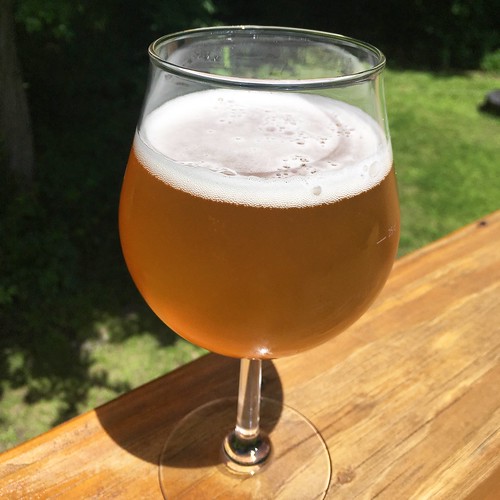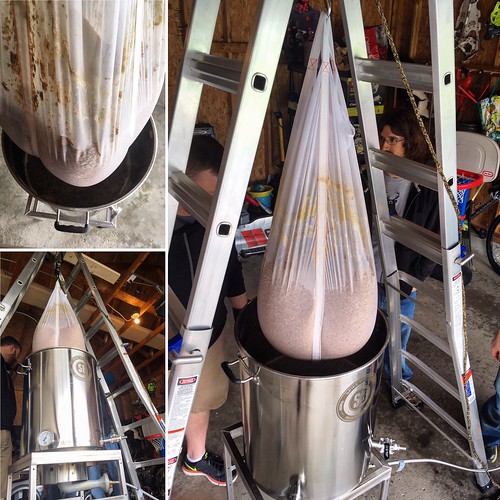Homebrew #35: Sorachi Ace Clone
¶ by Rob FrieselI can’t really take credit for this one. I showed up to help with the brewing, and I pitched my own yeast… but in most ways I was just an innocent bystander. That being said, I’m an innocent bystander who, for his part, got a delicious saison out of the deal. A clone of Brooklyn Brewery’s Sorachi Ace Saison:
A friend of mine (Aaron) had just picked up a new 30 gallon kettle and was itching to take it on its maiden voyage. He kicked around a few ideas and ultimately settled on a clone recipe for Brooklyn Sorachi Ace. He found a good deal on the hops, picked up a 50 lb. bag of BestMalz Pilsen malt, and put out the call…
Brew Day
Aaron scheduled his 30 gallon kettle’s maiden voyage for May 6 — not coincidentally: AHA’s National Homebrew Day! Needless to say, he registered it as an official “Big Brew Day” event. We commenced crushing and kettle-filling at 9:00am sharp.
By 11:00am we were mashing in…
By noon we were lifting that BIAB sack out… (Thank goodness for pulleys!)
(See also: this video.)
Then of course boiling…
…and chilling…
…and carboy-filling.
As an aside… as this wasn’t my system, I didn’t take my usual painfully-detailed notes. No mash pH, no post-mash vs. post-sparge gravity readings. The only real number I did come home with was the O.G. 1.074 — and a solid 12 points above where we expected.
Fermentation
Where to even begin…?
Regular readers here will recall that when I brewed Let the Wookiee Win (Mk. II), I over-built my starter of Wyeast’s 3726 Farmhouse Ale strain, with the idea that I would re-use it for this brew. Which is what I did: I pulled out the jar with the previous culture’s sample and used that to over-build this brew’s starter, with some set aside for future brews.
With my yeast ready, I pitched around 5:00pm on brew day. Fermentation started promptly (within a couple hours) and proceeded rather vigorously. Bubbles in the blow-off bucket were frequent and strong for a couple days, and the temperature probe was reading just a little shy of 80°F. Then things slowed down.
After four days, I took the first gravity reading to find it had come down to 1.032. OK so… not even close to being finished. I added two teaspoons of yeast energizer and bumped the temperature controller up a couple degrees. Three days later… gravity was down to 1.029. Ugh. This was beginning to look a lot like what happened with that last batch of Wookiee: 3726 seems to like to burn through about half of the wort really fast and then take it’s sweet ass time inching down to final gravity.
Fast-forward another two-and-a-half weeks and I see that the gravity is sitting at 1.015.
Convinced that this is (finally) the final gravity, I proceed to add the dry hops.
Five days later, I pull the dry hops and — just to be sure — take another gravity reading. To my surprise, it had come down even further: 1.011!
Taking some advice from some other club members, I decided to avail myself of that greatest of all homebrewer virtues: patience. As much as I wanted to get this beer packaged and start drinking it, I let it sit and condition for another two weeks. Finally — for real this time — it reached a final gravity of 1.008.
From there? Cold crash for 24 hours; fine with gelatin and let it settle for another 48 hours; then mix it up with a corn sugar-based priming solution and let it carbonate for two weeks.
Overall Impressions and Conclusions
When I finally poured the first bottle, I felt like that patience had paid off. The beer had some great aromas and flavors: that lush lemongrass that I associate with Sorachi Ace, a moderate apricot note, and hints of dill. The saison yeast offer up some peppery flavors, particularly mid-palate. The malt profile is aligned with what I expect from pilsner: a light sweetness, soft, the faintest touch of grainy. The mouthfeel on this one is silky, and while it is dry, I still wonder if it didn’t fully attenuate.
Also, I strongly suspect that I won’t be using the 3726 strain again. While I wouldn’t go so far as to say that it stalled, the long and sluggish tail of its fermentation really tried my patience both times I used it. It’s possible that I didn’t provide the right kind of environment for it. Both times, I fermented on the warm side — mid- to upper-70s °F, while allowing it to free-rise. The reading I’d done had suggested that this hot fermentation temperature would help to develop the kind of esters that I find desirable in saisons. That being said, it was strange to watch the fermentation effectively resume after removing the carboy from the (hot) fermentation chamber and putting it into a cooler environment (i.e., my “conditioning closet”). If I use the strain again, I’ll try to keep it on the cool side — but I also suspect I’ll try line up something like Wyeast’s 3711 or White Labs’ WLP566 or WLP590.
Recipe
The all-grain BIAB recipe for Sorachi Ace Clone is as follows.
Mash Grains
50 lb. BestMalz Pilsen Malt
Fermentables
4 lb. table sugar
Hop Schedule
- 2 oz. Sorachi Ace (60 min.)
- 2 oz. Sorachi Ace (30 min.)
- 10 oz. Sorachi Ace (at flame-out)
- 10 oz. Sorachi Ace (15 min. steep/whirlpool at 150°F)
- 10 oz. Sorachi Ace (dry hop 5 days) 1
Yeast
“B.Y.O.Y.” Bring your own yeast. Each brewer that took home a portion pitched a different strain. The clone recipe that Aaron found called for Wyeast 1214. For what it’s worth (and as discussed above), I pitched:
Approx. 200 ml Wyeast 3726 Farmhouse Ale slurry
Brew Day
- Collect 75 qt. water and heat to 160.2°F. Mash in; hold at 148°F for 60 minutes. No mash-out.
- Remove filter bag from water. Squeeze filter bag to extract as much liquid as possible for wort. Sparge as necessary to reach pre-boil kettle volume. Pre-boil kettle volume should be approx. 24 gal.
- Bring to a boil. Add 4 lb. table sugar. Boil for 60 minutes, following hop schedule described above.
- After knock-out, add 10 oz. Sorachi Ace hops. Chill to 150°F as rapidly as possible. Add 10 oz. Sorachi Ace hops and steep/whirlpool for 15 minutes.
- Cool to 70°F as rapidly as possible.
- Aerate wort and pitch Wyeast 3726 Farmhouse Ale yeast.
Beyond Brew Day
- Ferment at 76°F for 2 days, but allow to free-rise as much as it wants.
- After 2 days, raise temperature to 80°F and add 2 tsp. of yeast energizer.
- Allow fermentation to complete (approx. 3-4 weeks); if yeast seem slow to reach terminal gravity, consider raising the temperature to 84°F.
- After reaching terminal gravity, add dry hops and let stand 5 days.
- Remove dry hops and consider cold crashing and fining for 1-3 days before packaging.
- Use corn sugar to carbonate on bottling day. Rack beer into bottling bucket and bottle.
- Allow at least 2 weeks to carbonate.
- Enjoy.
Details
Sorachi Ace Clone, a dry hopped saison brewed in conjunction with Ritchie Brewing
| Original Gravity | 1.074 |
| Final Gravity | 1.008 |
| ABV | 8.7% |
| Attenuation | 88.5% |
| IBU | 35 |
| SRM | 2.8 |
| Links | Untappd Flickr |
- The 10 oz. was split up into 2 oz. packs that were distributed for the five 4 gallon portions.[↩]










Leave a Reply